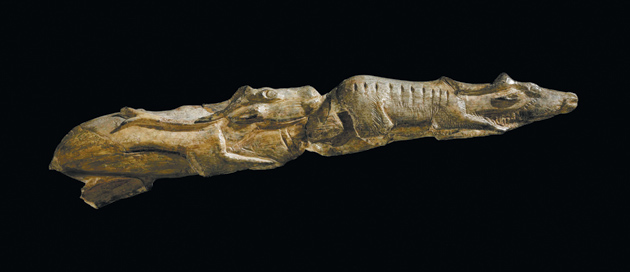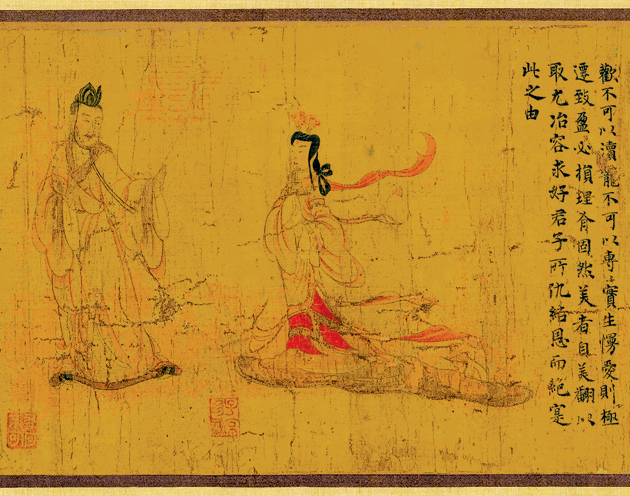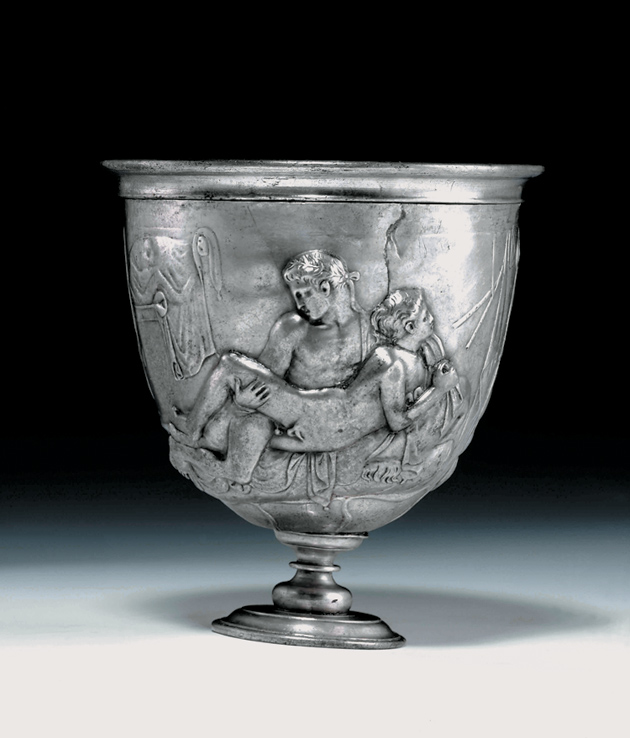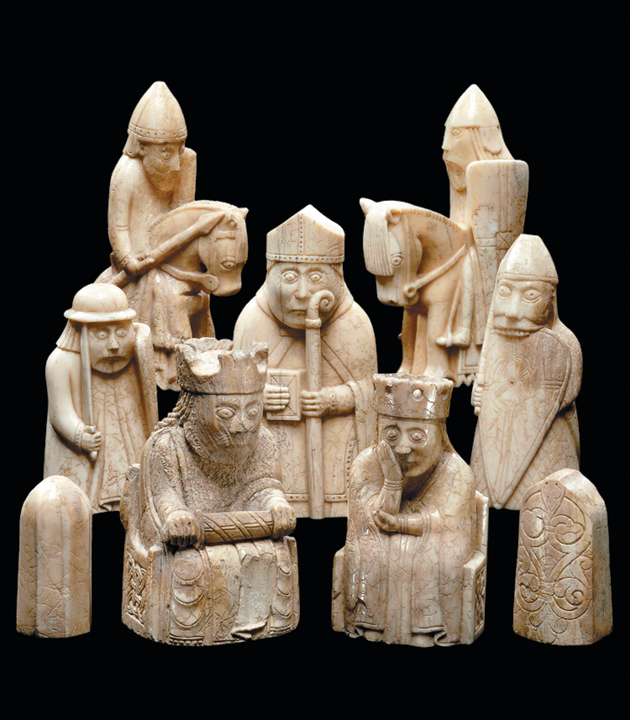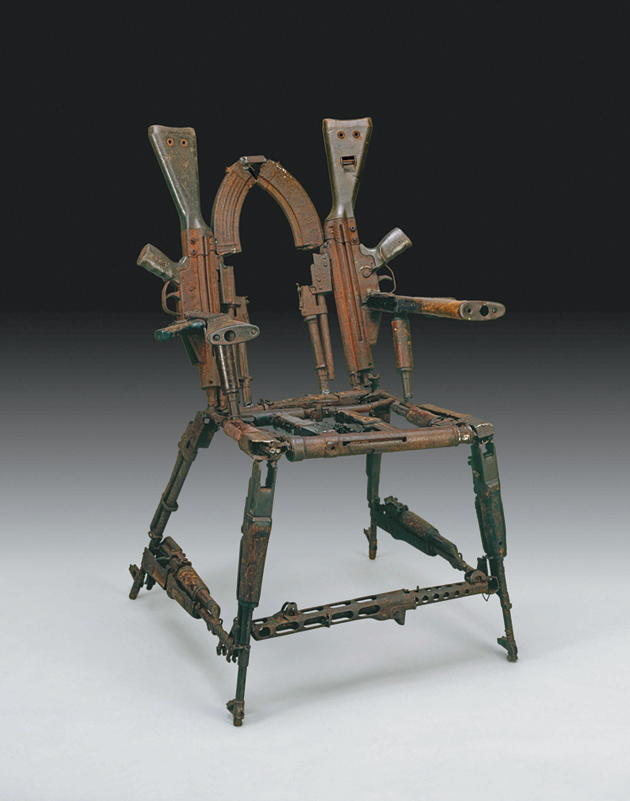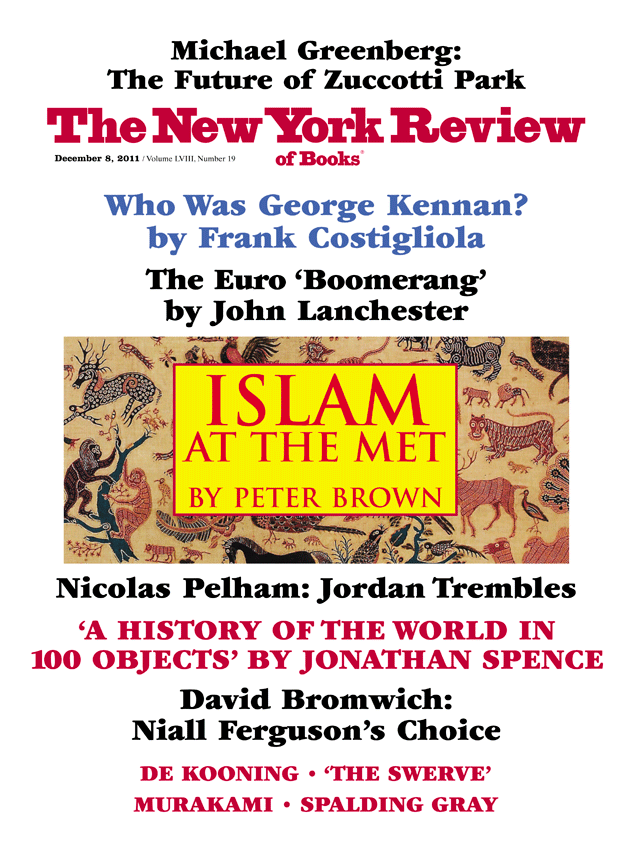There are no fixed rules for writing a history of the world. Unless one is tied to some text-bound pattern of belief, each of us can open the global story pretty much where we wish: by conjuring up a tiny speck in galactic time, by evoking primal creatures of the marsh, by feeling the heft of a chipped stone spear tip. Or we may take more personalized markers such as a shaper of nations, a trader in gold, a transcriber of tales, or a singer of songs.
Neil MacGregor has chosen to give structure to his history of the world by drawing on the capacious holdings of the British Museum, of which he is the director. This position gives him what is perhaps a paramount vantage point in selecting from the astonishing range of objects gathered in that wondrous institution. Initially founded in 1753 by the generosity of the polymath and collector Sir Hans Sloane, at a high point of Britain’s collecting fever, the museum was charged by Parliament with the obligation to develop a collection that would be “aimed at universality.”
MacGregor responded to that challenge two and a half centuries later by developing a joint project between the museum and the British Broadcasting Corporation’s Radio Four, which serves essentially as the BBC’s cultural connector to the public at large. In this project, MacGregor and his colleagues, in consultation with the BBC, would choose one hundred objects from the museum’s enormous holdings, around which they would develop one hundred radio programs, to be broadcast during the year 2010, on a schedule of five programs a week for twenty weeks. The first object illustrated in A History of the World in 100 Objects is a beautiful wooden mummy case from Thebes, dated around 240 BC. The last is a solar-powered lamp and charger made last year in China.
During the development phase of the project, MacGregor and his staff drafted one hundred brief essays and, in consultation with the BBC, invited writers, artists, and scholars from Britain, the United States, and many other countries to respond with comments of their own on one (or occasionally more) of the one hundred programs. These comments, often quite lengthy or emotionally charged, were then edited sparingly, to keep their spontaneous flavor, and incorporated into the final versions of the broadcast transcripts of the hundred programs. Since this was a radio program, and thus presented without visuals, the originals were on special display in the British Museum; they were also photographed and made available on a comprehensive website for those who could not see the originals in London.
The book as we now have it is thus a compilation of the one hundred objects, arranged more or less chronologically (since many cannot be dated with precision), each with essay and commentary as edited for final broadcast format, with attached writings from outside participants, color or black-and-white full-page photos of each item, and well-annotated maps that give the location at which each one of the hundred was found—though inevitably this information is not available in every case. Various bibliographic references to each contributor and object are also included.
The resulting volume as we now have it weighs in at 707 pages. A simple sampling of the book’s capacious indexes supports the intention of the British Museum and the BBC to cover as wide a geographical span as possible. Perhaps surprisingly there was a tie for first place in the number of references between China and the Americas (North, South, and Central). Britain/Britons tied for third place with Iran/Iraq. Fifth place was also a tie, between Egypt and Mexico. The most referenced concepts were Christianity, gods, Muslims, power/authority, religions/beliefs, trade, and writing. After that, the field was wide open.
MacGregor is disarming in his introductory comments to the book, and at one point he states that “this book might perhaps have been more accurately titled A History of Objects Through Many Different Worlds. But one advantage of the current title is, as he tells us, that a history of the world told through objects, as long as the treatment is made with “sufficient imagination,” should be “more equitable than one based solely on texts.” In his view, the central impact of being “equitable” is that it “allows many different peoples to speak.” Yet this raises other problems in its turn:
A history through objects, however, can never itself be fully balanced because it depends entirely on what happens to survive. It is particularly harsh on cultures whose artefacts are made mostly of organic materials, and especially so where climate will cause such things to decay: for most of the tropical world, very little survives from the distant past.
Because over millennia we have spent so much time concentrating on texts from the past, “we have centuries of critical apparatus to assist our assessment of written records. We have learnt how to judge their frankness, their distortions, their ploys.” In the history of objects, however, even this “partial certitude” eludes us. The best we can do in such circumstances is to make “a considerable leap of imagination, returning the artefact to its former life, engaging with it as generously, as poetically, as we can in the hope of winning the insights it may deliver.”
Advertisement
In a collaborative venture as complex as this one, in which certain tried and true textual guidelines are seen as only partially relevant to our current preoccupations, obviously the editorial task of carving out the new blocks for investigation becomes a personal matter as well as a historiographical one. Thus at a certain level we evaluate MacGregor’s labors by way of his organizational structure—realizing also that this is a complex process involving numerous minds, in the radio as well as the museum world, not to mention the cumulative weight of the outside commentators. But as a guide to giving some perspective to our reading of the objects, the chronological framework MacGregor constructs to link his explorations into a shared world of terms is a useful one. It is especially valuable just because the main categories overlap so much more than they would in the once-conventional linear manner.
Following the broadcast arrangement of one hundred sections spread across twenty weeks, we can separate out the following rough guide to the whole structure. Parts One to Six focus on early human inventions and explorations, such as the shaping and sharpening of tools, the first modeling of forms, and the growth of communities, which merge into the increasing complexity of understandings of food and sex; the formation of early empires from Egypt to China; and the development of writing systems and scientific investigations. Parts Seven to Fourteen show the range of human curiosity, from the Rosetta Stone, the new religious faiths from Shiva to Easter Island, the silk road, Mayan culture, and the elements of trade and status that were linked to all the expansive movements of people and ideas. In the last part of the book, Parts Fifteen to Twenty, MacGregor sees a new shift of focus, a new range of structural changes, that take humans across the “threshold of the modern world” and into the “first global economy,” and thence to our current universe of “mass production” and “mass persuasion.”
But such a brief outline is skeletal indeed, and this book’s main strength resides in the details rather than in broad generalizations. Regardless of the sweeping panoramas, each of the sections has something interesting to say, and prior knowledge of a given topic does not prevent us from gathering new insights from the text and the illustrations, and new angles of vision. Some of the images scattered through the book are so astonishing and so far from our usual perceptions that I don’t think I will ever forget them. For strength of purpose in motion, how could one better the image of two reindeer, carved from a mammoth tusk around 11,000 BC, discovered in France? The deer bodies are linked together, their heads thrown back with effort, swimming fiercely against the current: it is an extraordinary image of power and compression.
A very different type of imaging can be seen in the patterns of concentration and anxiety caught in the faces of a set of early chessmen. Carved from walrus ivory and whales’ teeth around the year 1150 AD, found on the Scots Isle of Lewis (though possibly made in Norway), these figures catch the aura of fierce self-absorption that precedes the conflict to come, as the mounted knights, thoughtful king, and already grieving queen surround their bishop, who holds firmly onto his Bible and his crosier. Many other aspects of battle, death, and slavery, and the fates of the long lines of refugees, not yet resigned to their fate, are shown in Egyptian and Assyrian paintings and bas-reliefs, as the vanquished enemies are led toward an unknown life at the hands of their new Egyptian masters.
But as an image and memento of the agonies of war, I have never seen anything that quite equals in force the monstrous metallic chair sculpted and assembled with grim precision by the Mozambique artist Kester in 2001 AD. In memory of the one million–plus victims of civil war in his country, Kester chopped apart and reconfigured the abandoned weapons of both loyalists and rebels in his homeland into this grim and fanciful work of art. This handful of images is the merest fraction of the one hundred assembled in the volume. Because of the local practices at the time of creation, the images are mostly anonymous, but they serve to remind us, as MacGregor writes in his introduction, that for the history of objects to have maximum impact the author must call on both imagination and originality.
Advertisement
It also remains true that the kind of history found in MacGregor’s book is going to be sparse on names, places, and even specific issues. The rigid format of the book, with its units of five, twenty, and one hundred items, can also be constricting and end up preventing the construction of logical connections between parallel sets of circumstances. So perhaps the best way to evaluate MacGregor’s history of the world with a bit more precision than we have done so far is to give a clearer example of its linkages across time and space, to move from the object to the sources and the argument. Let us take a randomly chosen slice of the book, the one listed as Part Eight, and see where it leads us.
Part Eight is entitled “Ancient Pleasures, Modern Spice,” and states its setting to be the time span from 1 AD to 500 AD. Like every other one of the twenty separate parts that cumulatively form the book as a whole, this Part Eight is composed of five distinctly identified sections, which in the book are numbered as Sections 36 through 40. Each section has its own title, and each of them is between five and six pages long. The first in order of the five sections is number 36, which is titled “Warren Cup.” A silver Roman drinking cup, it is dated 5–15 AD. Section 37 is titled “North American Otter Pipe” and its dates given as 200 BC–100 AD. Section 38 is titled “Ceremonial Ballgame Belt” and dated 100–500 AD. Section 39 is called “Admonitions Scroll” and dated 500–800 AD. The fifth and last section, titled “Hoxne Pepper Pot,” is dated 350–400 AD. In addition, each of the five is labeled according to the British Museum system, with the location where it was first discovered or observed. The Warren Cup is described as having been found in the town of Bittir, near Jerusalem. The North American Otter Pipe is described as having been found in Mound City, Ohio. The provenance of the Ceremonial Ballgame Belt is listed as “found in Mexico.” The Admonitions Scroll is simply labeled “Painting, from China.” And the Hoxne Pepper Pot is listed as “Found in Hoxne, Suffolk, England.”
Each of these five disparate objects is certainly worth studying, and can be seen as contributing to our knowledge of a different aspect of the society of the time in which it was found. MacGregor’s text on each of the items is pithy and full of information, and he introduces the reader to many elements of the various periods—spanning some seven or eight hundred years in all—and ranging in space from the outposts of the Roman Empire to Mexico, Ohio, and China. Each of the five sections brings new vantage points from which we can reflect on the objects he presents, and cumulatively they stretch the range of our imaginations.
In Section 36 on the Warren Cup, the literal representations of male same-sex unions in the reliefs on the cup are surprisingly frank, and may serve to shock, as well as to illuminate some of the customs of the Roman Empire in its heyday. One detail makes a particularly vivid moral commentary on the period; as is pointed out in the discussion of the cup, our gaze is artfully deflected from the sexual action to a vignette in which we see a servant boy peeking through one of the doors carelessly left ajar, and so through his eyes as well as ours we can make our own commentary on life’s vagaries.
Of a very different nature, and also well analyzed by MacGregor, is the cult of tobacco smoking revealed by the Otter Pipe discoveries, in the region that later became the state of Ohio. As discussed in the commentary on Section 37, tobacco smoking through small pipes was a fundamental part of many social ceremonies and in diplomacy, but the imagery of the otter seems to have been an integral part of many pipe designs. As is shown in both the illustrations and the text, the stem of the pipe was carved near the mouthpiece with an otter motif that had the curious effect of making the otter’s face a part of the pipe design in both its private and its public uses.
In the act of inhaling the smoke from the pipe, the smoker found himself in some kind of communion with the otter: from the smoker’s perspective, in the words of a commentator, “the otter looks along the pipe so that, as you smoke it, you and the otter are gazing into each other’s eyes.” It is a striking picture, and one that leads MacGregor on to the topic of spirit guides and totems, and from there to the pungent attack on smoking made by King James I in 1604, in which he blasted tobacco as being a “blacke stinking fume,” and as “neerest [sic] resembling the horrible Stigian smoke of the pit that is bottomlesse.”
In the third of the sections, entitled “Ceremonial Ballgame Belt,” MacGregor opens up another aspect of the moral and social dimensions of the time, by focusing on the arena of competition in a structured conflict between two skilled players. Information on these competitions came partly from Spanish Dominican friars serving their missions in Mexico, and partly from firsthand accounts, and even from a detailed painting of two Aztec ball-players who were brought by Spaniards to the court of Emperor Charles V in 1528. Though not all the details are clear, the basic structure of the game was for the players to keep a heavy and bouncing rubber ball in play and in the air, butting it between them with their bodies, for as long as possible, without having it touch their hands, head, feet, or the ground. Teams could consist of as few as two or as many as seven. Sometimes watched by large crowds, they each tried to maneuver the other into committing faults on the court, and thus having to forfeit the game.
But as MacGregor writes, these “games” also had facets we barely understand, which involved the ceremonial use of polished stone belts or supports modeled after giant toads, and perhaps worn in some way either before or during the actual competitions. MacGregor guesses that the real-life toads, from which the sculpted versions were drawn, might perhaps have had hallucinogenic effects that sharpened the players’ skills, or even, perhaps, the way that “Meso-Americans view the world.” True to his mission of glossing largely unknown facets of the past, MacGregor includes in this account a celebration of the rubber ball as a diversion: it became widely known in the early sixteenth century or earlier, where it is described by a Spanish Dominican friar as “jumping and bouncing…upward and downward, to and fro. It can exhaust the pursuer running after it before he can catch up with it.” For a time, we are told, Aztecs accepted thousands of the rubber balls in lieu of tax payments.
The last two of the examples from Part Eight of the book, Sections 39 and 40, both take us into different regions, one in China and one in Roman Britain. They explore two more aspects of the cross-cultural story: one of these, the Chinese Admonitions Scroll, focused on Chinese courtly life, and especially on women’s roles within that system; the other celebrates culinary practices in Britain under the Roman occupation. The pepper pot made of silver celebrates an object used in gourmet dining, and fits admirably into MacGregor’s broadly conceived panorama of the varieties of life in that society. The object was small, but filled with the rare spice pepper would have stood out as an exemplary case of high taste in those troubled times. Perhaps it was even more treasured in Roman Britain, MacGregor tells us, because a select or “high-end menu” of that time in England would include such rarities as “dormice sprinkled with honey and poppy seeds.”
However, the use of the British Museum’s celebrated Admonitions Scroll as one of the hundred “objects” strikes me as presenting several problems. At one level this is a justly famous series of early paintings that was used to convey moral arguments concerning female deportment in the palace. As he writes, half the scroll is made up of painted scenes, each divided from the next by lines in the poem. The scroll drew from early Chinese poetry, literature, and art to present a montage in which court women showed courage, virtue, and modesty in the face of various temptations—most especially in the virtuous women’s relationships with their nominally all-powerful emperors.
That sounds simple, but in fact these scrolls were drawn from multiple sources, artistic and poetic as well as moral, and it would be hard to find any “objects” that had such convoluted antecedents. This was a living document, subject to alteration and adjustment; it raised questions of skill and connoisseurship, of moral values under challenge. The scroll was thus quite different from the erotic cup, the fragrant smoke, the heavy rubber ball, or the silver pepper pot. And to me, it stands out as an anomaly in the book as a whole, a sign of realms not yet explored, let alone mastered.
As suggested by the discussion above, just these randomly chosen five sections of MacGregor’s History of the World, numbered sequentially from 36 to 40, can give us a flood of information. MacGregor writes with energy and flair, and this is an entertaining and informative book, a book of “ostentatious refinement,” to use his own term. But despite MacGregor’s strenuous labors, it is hard to find any consistent linkages between any two chapters of Part Eight, let alone between the wider range of chapters that constitute the bulk of the volume. I can imagine that these programs were enjoyable to listen to on the radio, but despite the hard work and the goodwill that went into them, they do not really make up a unified or coordinated work.
But total synthesis was never MacGregor’s objective, and he does not make inflated claims for the book as a whole. In one of his best asides, he tells us that the precious Hoxne silver pepper pot lay buried and forgotten in Suffolk from around 400 AD until 1992. In that year a Suffolk farmer named Eric Lawes went hunting with a metal detector for a favorite hammer that he had lost in the fields. What he found instead were the Hoxne treasures, still carefully wrapped and stored in their container. Because of his care, the treasures were kept intact until experts from the British Museum could check and analyze them. Subsequently, the farmer also found his hammer, which has also been added to the museum’s permanent collections. It is a grand story, with a happy ending. But that happy outcome does not exactly deepen our historical sensibility, or lead us onward and outward to a deeper understanding of the human adventure. This compilation is a brave and original undertaking, but our search for an integrated and new approach to the history of the world seems destined to continue.

